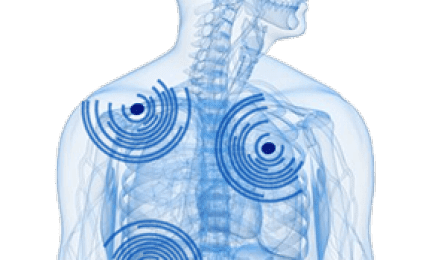
Interconnected wireless body sensors could use sonar to treat diabetes, heart failure and other ailments
The military has for decades used sonar for underwater communication.
Now, researchers at the University at Buffalo are developing a miniaturized version of the same technology to be applied inside the human body to treat diseases such as diabetes and heart failure in real time.
The advancement relies on sensors that use ultrasounds – the same inaudible sound waves used by the navy for sonar and doctors for sonograms – to wirelessly share information between medical devices implanted in or worn by people.
“This is a biomedical advancement that could revolutionize the way we care for people suffering from the major diseases of our time,” said Tommaso Melodia, PhD, UB associate professor of electrical engineering.
His research, “Towards Ultrasonic Networking for Implantable Biomedical Device,” is supported by a five-year, $449,000 National Science Foundation (NSF) CAREER grant. The CAREER award is the foundation’s most prestigious for young investigators.
Details of Melodia’s work can be found at:http://1.usa.gov/17y2njQ.
The idea of creating a network of wireless body sensors, also called a “body area network,” is not new. Development of the technology began roughly 10 years ago.
But most work has focused on linking sensors together via electromagnetic radio frequency waves – the same type used in cellular phones, GPS units and other common wireless devices.
Radio waves can be effective but they have drawbacks such as the heat they generate. Also, because radio waves propagate poorly through skin, muscle and other body tissue, they require relatively large amounts of energy, he said.
Ultrasounds may be a more efficient way to share information, Melodia said, because roughly 65 percent of the body is composed of water. This suggests that medical devices, such as a pacemaker and an instrument that measures blood oxygen levels, could communicate more effectively via ultrasounds compared to radio waves.
“Think of how the Navy uses sonar to communicate between submarines and detect enemy ships,” Melodia said. “It’s the same principle, only applied to ultrasonic sensors that are small enough to work together inside the human body and more effectively help treat diseases.”
Another example involves connecting blood glucose sensors with implantable insulin pumps. The sensors would monitor the blood and regulate, through the pumps, the dosage of insulin as needed in real time.
“We are really just scratching the surface of what’s possible. There are countless potential applications,” he said.
The Latest Bing News on:
Wireless body sensors
- Sennheiser's new wireless earbuds are packed with features, but cheaper than Sony, Bose and AirPods Proon May 7, 2024 at 7:59 am
Sennheiser's Accentum True Wireless are smartly priced earbuds in a competitive headphones market – but should you buy them?
- In-depth Analysis: Temperature Sensor Market Share Insights Revealedon May 7, 2024 at 12:41 am
The Temperature Sensor Market Size is projected to rise from USD 7.4 billion in 2024 to USD 9.7 billion in 2029 at a compound annual growth rate (CAGR) of 5.6%.
- Sennheiser debuts new ergonomically shaped wireless earbudson May 6, 2024 at 9:16 am
Sennheiser’s new $200 Accentum True Wireless earbuds look different from the company ... including active noise cancellation (ANC), transparency mode, wear sensors, Bluetooth multipoint, Bluetooth 5.3 ...
- The Most Innovative Wireless Earbudson April 26, 2024 at 11:41 am
The Sennheiser Momentum Sport true wireless earbuds aren’t the first to take measurements of various vitals. But they’re an interesting new design in terms of earbuds that combine audio with training ...
- Best wireless gaming mice 2024: Tested and approvedon April 22, 2024 at 7:06 am
Now that wireless gaming mice are just as ... A premium-level, very accurate 32,000 DPI sensor and a lightweight symmetrical body are its best assets, that make it a cinch to move and aim.
- Best gaming mice 2024: Find your perfect matchon April 18, 2024 at 2:01 am
The HyperX Pulsefire Haste 2 Wireless features a lightning-fast 26,000 DPI sensor, Bluetooth and 2.4GHz ... turn knobs integrated into the mouse’s body, so there’s a fairly steep learning ...
- CDR Wireless Intraoral Sensors from Sironaon April 7, 2024 at 5:00 pm
CDR Wireless offers all the advantages of our standard sensors, but uses radio frequency transmission to eliminate the usual wired connection. Now one can experience unprecedented freedom of ...
- Scientists create salt-sized sensor to unlock mind secrets wirelesslyon March 19, 2024 at 4:35 am
The innovative approach advances the evolution of wireless sensor technology ... demanding environment for these sensors will always be inside the human body.
- Wireless ultrasonic sensors for fast detection of defectson June 29, 2022 at 8:21 am
Compact, wireless sensors that provide fast, lower cost measurements on corrosion, cracks, and other defects in reactors, pipelines and other structures. Equipment used by the nuclear power, oil and ...
- Snails, Sensors, And Smart Dust: The Michigan Micro Moteon October 4, 2021 at 3:15 am
The term “mote” refers to a wireless sensor node that can measure some ... designed to measure the pressures inside the human body. Such a measurement can be useful in diagnosing glaucoma ...
The Latest Google Headlines on:
Wireless body sensors
[google_news title=”” keyword=”wireless body sensors” num_posts=”10″ blurb_length=”0″ show_thumb=”left”]
The Latest Bing News on:
Body area network
- Uber: Driving Success With Network Effect And Improving Financialson May 6, 2024 at 5:03 am
Uber's ability to operate across multiple platforms and channels efficiently has allowed it to cross-sell effectively. Find out if UBER stock is a buy.
- The Learning Networkon May 6, 2024 at 12:46 am
By The Learning Network New federal rules will require school cafeterias to reduce the amount of salt and sugar in the foods they serve. Do you think students will embrace the changes?
- Versa Networkson May 5, 2024 at 5:00 pm
The company was founded by security and network industry veterans. It is a SASE, security, networking, SD-WAN, cloud, and analytics player. Its solutions help transform wide area networks and ...
- Death Toll Rises To Four As Another Worker's Body Recovered From Coal Mine In Central Kurramon May 1, 2024 at 1:03 pm
In the Ali Sherzai area of Central Kurram, the body of another worker has been retrieved from the coal mine, bringing the death toll to four individ ...
- Body leads to arrest of man caught with dead man's vehicle, North Carolina deputies sayon April 29, 2024 at 12:47 pm
The body of a man found earlier this month led deputies to the arrest of a man for what he was doing with the dead man's property, deputies said.
- New York DA Sandra Doorley apologizes after body cam captures tense exchange with officeron April 29, 2024 at 11:55 am
A New York district attorney was pulled over for speeding. Sandra Doorley of Monroe County issued a public apology. Watch the viral traffic stop video.
- Body found in river in Georgetown County, South Carolina, deputies sayon April 29, 2024 at 6:13 am
A body was recovered from a river in Georgetown County, South Carolina, according to the Georgetown County Sheriff's Office.
- Interstitium: A Network of Living Spaces Supports Anatomical Interconnectednesson April 26, 2024 at 8:29 am
What researchers once regarded as a byproduct of biology may hold the key to understanding health and disease.
- Cuban government apologizes to Montreal-area family after delivering wrong bodyon April 24, 2024 at 5:00 pm
MONTREAL (CTV Network) — Cuba’s foreign affairs minister has apologized to a Montreal-area family after they were sent the wrong body following the death of a loved one. Faraj Jarjour ...
- Wide Area Network Definitionon April 18, 2024 at 5:00 pm
A Wide Area Network, or WAN, is a series of smaller LANs (Local Area Networks) that are interconnected through various means over very large distances whether they be cities, states, or even ...
The Latest Google Headlines on:
Body area network
[google_news title=”” keyword=”body area network” num_posts=”10″ blurb_length=”0″ show_thumb=”left”]









